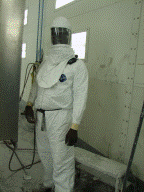Industrial Hygiene Blogs So Far
This is the fourth in a series of blogs on industrial hygiene (IH). The first one explained that industrial hygiene was the recognition, evaluation, and control of hazards in the workplace. The second blog defined a hazard as a source of danger or an agent which has the potential to cause to harm to a vulnerable target. Sources of hazards were identified in manufacturing, construction, maritime, office, and other workplaces. Different types of resources were identified such as guidelines provided by the U.S. Occupational Safety & Health Administration (OSHA, www.osha.gov) and the National Institute of Occupational Safety & Health (NIOSH, www.cdc.gov/niosh). The third blog focused on the recognition or identification of hazards. And, this blog will walk you through an example of hazard recognition for a specific operation.
IH Hazard Recognition Example
 Let’s say the operation is spray painting a finished metal part before shipping. The part comes into the paint spray booth already deburred and sanded. It is ready to paint. The operation involves the following tasks:
Let’s say the operation is spray painting a finished metal part before shipping. The part comes into the paint spray booth already deburred and sanded. It is ready to paint. The operation involves the following tasks:
- Clean/degrease the part
- Allow part to dry
- Fill paint pot with primer
- Spray part with primer
- Allow part to dry
- Sand primed surface to smooth it before final coat of paint
- Clean sanding debris from part
- Fill new paint pot with finishing paint
- Spray paint with finishing paint
- Allow to dry then send to shipping department
- Clean out spray guns and paint pots
So what are the hazards that you can identify? Steps 1 and 2 could present an inhalation and skin absorption hazard due to the use of solvents containing volatile organic compounds (VOCs). This could also be true for Steps 3, 4, 5, 8, 9, 10, and 11 depending on the chemicals present in the primer and finish paint. Additionally, during spraying, there could be a hazard associated with particulates. This is also true of the sanding and cleanup in Steps 6 and 7. There also may be metals of concern in the sand paper.
In terms of recognizing the specific potential hazards of most concern, that will depend on the constituents in the cleaner/degreaser, primer, sandpaper, and finish paint. Without that information, the potential hazards of most concern will likely be vapors and particulates from the spraying steps. How can you know? That is where the industrial hygiene evaluation comes in. But that will be covered in our next blog.
 So that concludes our discussion of hazard recognition in industrial hygiene. In our next blog in this series, we will discuss the evaluation of potential industrial hygiene hazards. That process often includes industrial hygiene testing. In the meantime, if you need any help, Environmental Safety Consultants (www.escflorida.com) is here. We are a Florida licensed environmental engineering company with a CIH on staff. We have the credentials and experience to help you complete your industrial hygiene project. We have a proven track record with a Florida licensed environmental engineer and mold assessors, plus degreed environmental scientists on staff. We specialize in industrial hygiene, indoor air quality, asbestos, lead paint, silica, noise, and more. We are just a telephone call (800-226-1735) or an e-mail away (escinc@verizon.net). Contact us today!
So that concludes our discussion of hazard recognition in industrial hygiene. In our next blog in this series, we will discuss the evaluation of potential industrial hygiene hazards. That process often includes industrial hygiene testing. In the meantime, if you need any help, Environmental Safety Consultants (www.escflorida.com) is here. We are a Florida licensed environmental engineering company with a CIH on staff. We have the credentials and experience to help you complete your industrial hygiene project. We have a proven track record with a Florida licensed environmental engineer and mold assessors, plus degreed environmental scientists on staff. We specialize in industrial hygiene, indoor air quality, asbestos, lead paint, silica, noise, and more. We are just a telephone call (800-226-1735) or an e-mail away (escinc@verizon.net). Contact us today!
